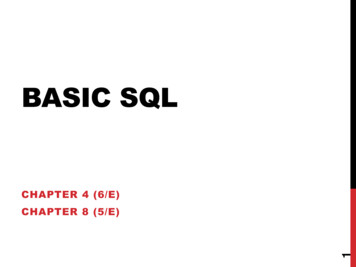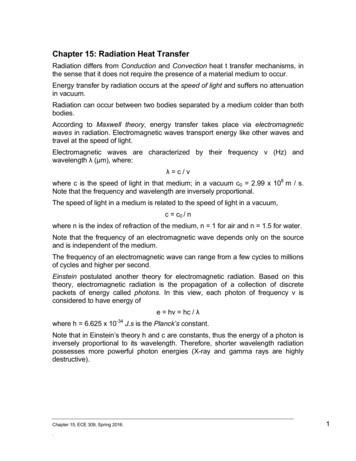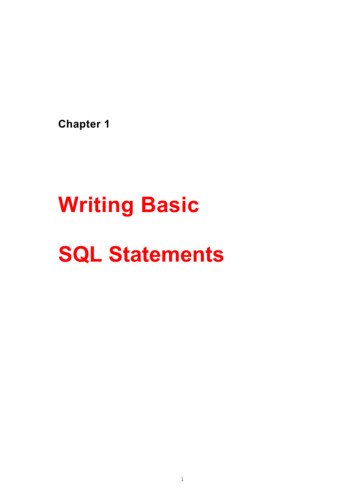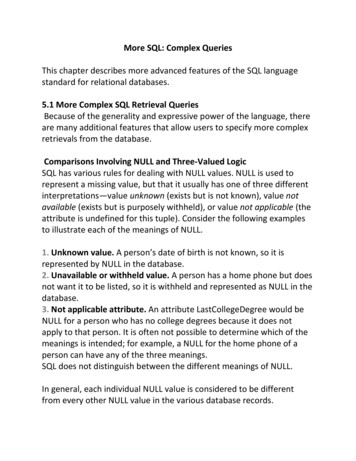
Transcription
BASIC SQLCHAPTER 4 (6/E)1CHAPTER 8 (5/E)
LECTURE OUTLINE SQL Data Definition and Data Types Specifying Constraints in SQL Basic Retrieval Queries in SQL2 Set Operations in SQL
BASIC SQL Structured Query Language Considered one of the major reasons for the commercial success ofrelational databases Statements for data definitions, queries, and updates Both DDL and DML Core specification plus specialized extensions Terminology:Relational ModelSQLrelationtabletuplerowattributecolumn3 Syntax notes: Some interfaces require each statement to end with a semicolon. SQL is not case-sensitive.
SQL DATA DEFINITION CREATE statement Main SQL command for data definition SQL schema Identified by a schema name Includes an authorization identifier (owner) Components are descriptors for each schema element Tables, constraints, views, domains, and other constructs CREATE SCHEMA statement4 CREATE SCHEMA COMPANY AUTHORIZATION ‘Jsmith’;
CREATE TABLE COMMAND Specify a new relation Provide name Specify attributes and initial constraints Base tables (base relations) Relation and its tuples are physically stored and managed by DBMS Can optionally specify schema: CREATE TABLE COMPANY.EMPLOYEE .or CREATE TABLE EMPLOYEE . Include information for each column (attribute) plus constraints5 Column name Column type (domain) Key, uniqueness, and null constraints
BASIC DATA TYPES Numeric data types Integer numbers: INT, INTEGER, SMALLINT, BIGINT Floating-point (real) numbers: REAL, DOUBLE , FLOAT Fixed-point numbers: DECIMAL(n,m), DEC(n,m), NUMERIC(n,m), NUM(n,m) Character-string data types Fixed length: CHAR(n), CHARACTER(n) Varying length: VARCHAR(n), CHAR VARYING(n), CHARACTER VARYING(n),LONG VARCHAR Large object data types Characters: CLOB, CHAR LARGE OBJECT , CHARACTER LARGE OBJECT Bits: BLOB, BINARY LARGE OBJECT Boolean data type Values of TRUE or FALSE or NULL DATE data type6 Ten positions Components are YEAR, MONTH, and DAY in the form YYYY-MM-DD
MORE DATA TYPES Additional data types TIMESTAMP data type Includes the DATE and TIME fields Plus a minimum of six positions for decimal fractions of seconds Optional WITH TIME ZONE qualifier INTERVAL data type Specifies a relative value that can be used to increment or decrement an absolutevalue of a date, time, or timestamp Columns can be declared to be NOT NULL Columns can be declared to have a default value Assigned to column in any tuple for which a value is not specified Example7CREATE TABLE EMPLOYEE ( NICKNAME VARCHAR(20) DEFAULT NULL, Province CHAR(2) NOT NULL DEFAULT 'ON', );
);8);
DOMAINS IN SQL Name used in place of built-in data type Makes it easier to change the data type used by numerous columns Improves schema readability9 Example:CREATE DOMAIN SIN TYPE AS CHAR(9);
SPECIFYING KEY CONSTRAINTS PRIMARY KEY clause Specifies one or more attributes that make up the primary key of arelationDnumber INT NOT NULL PRIMARY KEY, Primary key attributes must be declared NOT NULL UNIQUE clause Specifies alternate (candidate) keysDname VARCHAR(15) UNIQUE; May or may not allow null values, depending on declaration If no key constraints, two or more tuples may be identical in allcolumns.11 SQL deviates from pure relational model! Multiset (bag) behaviour
REFERENTIAL CONSTRAINTS FOREIGN KEY clauseFOREIGN KEY (Dept) REFERENCES DEPARTMENT (Dnum), Default operation: reject update on violation Attach referential triggered action clause in case referenced tupleis deleted Options include SET NULL, CASCADE, and SET DEFAULT12 Foreign key declaration must refer to a table already created
SPECIFYING TUPLE CONSTRAINTS Some constraints involve several columns CHECK clause at the end of a CREATE TABLE statement Apply to each tuple individually13 Example CHECK (Dept create date Mgr start date)
EXAMPLE14 Recall Employee example:
15
16
BASIC SQL RETRIEVAL QUERIES All retrievals use SELECT statement:SELECTFROM[ WHERE return list table list condition ] ;where return list is a list of expressions or column names whosevalues are to be retrieved by the query table list is a list of relation names required to process thequery condition is a Boolean expression that identifies the tuplesto be retrieved by the query ExampleSELECT title, year, genreFROM FilmWHERE director 'Steven Spielberg' AND year 1990;18 Omitting WHERE clause implies all tuples selected.
SEMANTICS FOR 1 RELATION1. Start with the relation named in the FROM clause2. Consider each tuple one after the other, eliminating those that donot satisfy the WHERE clause. Boolean condition that must be true for any retrieved tuple Logical comparison operators , , , , , and 3. For each remaining tuple, create a return tuple with columns foreach expression (column name) in the SELECT clause. Use SELECT * to select all columns.FilmtitlegenreThe Company Mendrama2010John ven Spielberg15065,000,000181,408,467War Horsedrama2011Steven Spielberg14666,000,00079,883,359Argodrama2012Ben etgross19year
SELECT-FROM-WHERE SEMANTICS What if there are several relations in the FROM clause?1. Start with cross-product of all relation(s) listed in the FROM clause. Every tuple in R1 paired up with every tuple in R2 paired up with 2. Consider each tuple one after the other, eliminating those that donot satisfy the WHERE clause.3. For each remaining tuple, create a return tuple with columns foreach expression (column name) in the SELECT clause.Steps 2 and 3 are just the same as before.SELECT actor, birth, movieFROM Role, PersonWHERE actor name and birth 1940;movieArgoArgoThe Company MenThe Company MenpersonaTony MendezLester SiegelBobby WalkerGene McClaryPersonnamebirthBen Affleck1972Alan Arkin1934Tommy Lee Jones 1946cityBerkeleyNew YorkSan Saba20RoleactorBen AffleckAlan ArkinBen AffleckTommy Lee Jones
AMBIGUOUS COLUMN NAMES Same name may be used for two (or more) columns (in differentrelations) Must qualify the column name with the relation name to saleiddatecustidLineItemsaleid productquantitypriceSELECT name, date, product, quantityFROM Customer, Sale, LineItemWHERE price 100 AND Customer.custid Sale.custid ANDSale.saleid LineItem.saleid; Note21 If SELECT clause includes custid, it must specify whether to useCustomer.custid or Sale.custid even though the values areguaranteed to be identical.
2-RELATION SELECT-FROM-WHERESELECT award, actor, persona, Role.movieFROM Honours, RoleWHERE category 'actor' AND winner actorAND Honours.movie Role.movieawardCritic's ChoiceCritic's ChoiceSAGCritic's ChoiceBMI Flimcategoryactordirectorsupporting actorscreenplaymusicwinnerDaniel Day-LewisBen AffleckTommy Lee JonesTony KushnerJohn WilliamsRoleactorBen AffleckTommy Lee JonesDaniel Day-LewisDaniel Day-LewismovieArgoLincolnThe BoxerLincolnpersonaTony MendezThaddeus StevensDanny FlynnAbraham LincolnHonours.movie itic's ChoiceactorDaniel Day-LewisBen AffleckArgoTony MendezLincolnCritic's ChoiceactorDaniel Day-LewisTommy Lee JonesLincolnThaddeus StevensLincolnCritic's ChoiceactorDaniel Day-LewisDaniel Day-LewisThe BoxerDanny FlynnLincolnCritic's ChoiceactorDaniel Day-LewisDaniel Day-LewisLincolnAbraham LincolnArgoCritic's ChoicedirectorBen AffleckBen AffleckArgoTony MendezArgoCritic's ChoicedirectorBen AffleckTommy Lee JonesLincolnThaddeus StevensArgoCritic's ChoicedirectorBen AffleckDaniel Day-LewisThe BoxerDanny FlynnArgoCritic's ChoicedirectorBen AffleckDaniel Day-LewisLincolnAbraham LincolnLincolnSAGsupporting actor Tommy Lee Jones Ben AffleckArgoTony MendezLincolnSAGsupporting actor Tommy Lee Jones Tommy Lee JonesLincolnThaddeus StevensLincolnSAGsupporting actor Tommy Lee Jones Daniel Day-LewisThe BoxerDanny Flynn 22HonoursmovieLincolnArgoLincolnLincolnWar Horse
23RECALL SAMPLE TABLES
24
25
26
TABLES AS SETS IN SQL Duplicate tuples may appear in query results28 From duplicates in base tables From projecting out distinguishing columns Keyword DISTINCT in the SELECT clause eliminates duplicates
SET OPERATIONS29 Result treated as a set (no duplicates) UNION, EXCEPT (difference), INTERSECT Corresponding multiset (bag) operations: UNION ALL, EXCEPT ALL, INTERSECT ALL Arguments must be union-compatible Same number of columns Corresponding columns of same type
OTHER OPERATORS Standard arithmetic operators: Addition ( ), subtraction (–), multiplication (*), and division (/) [NOT] LIKE comparison operator Used for string pattern matching Percent sign (%) matches zero or more characters Underscore ( ) matches a single charactere.g., to also match Tommy Lee Jones as supporting actor:SELECT award, actor, persona, Role.movieFROM Honours, RoleWHERE category LIKE '%actor' AND winner actorAND Honours.movie Role.movie; [NOT] BETWEEN comparison operatorWHERE year BETWEEN 1990 AND 201030equivalent to WHERE year 1990 AND YEAR 2010
LECTURE SUMMARY Introduction to SQLComprehensive languageData definition including constraint specificationBasic SELECT-FROM-WHERESet operators31
BASIC SQL Structured Query Language Considered one of the major reasons for the commercial success of relational databases Statements for data definitions, queries, and updates Both DDL and DML Core specification plus specialized extensions Terminology: 3 Relational Model SQL relation table tuple row attribute column











